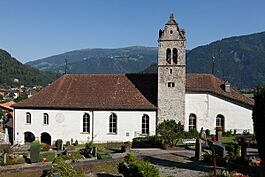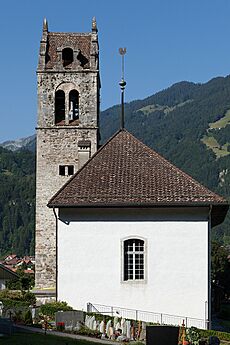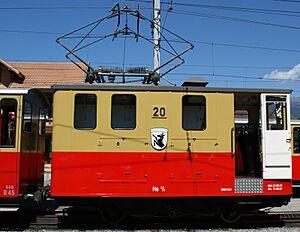Gsteigwiler facts for kids
Quick facts for kids
Gsteigwiler
|
||
|---|---|---|

Gsteig bei Interlaken village church
|
||
|
||
| Country | Switzerland | |
| Canton | Bern | |
| District | Interlaken-Oberhasli | |
| Area | ||
| • Total | 7.02 km2 (2.71 sq mi) | |
| Elevation | 645 m (2,116 ft) | |
| Population
(Dec 2020 )
|
||
| • Total | 402 | |
| • Density | 57.26/km2 (148.32/sq mi) | |
| Postal code |
3814
|
|
| Surrounded by | Matten bei Interlaken, Bönigen, Gündlischwand and Wilderswil | |
Gsteigwiler is a small town, also called a municipality, in Switzerland. It is located in the Interlaken-Oberhasli area in the canton of Bern.
Gsteigwiler is part of a larger group of towns called the Interlaken area. This area has about 23,300 people living in it (as of 2014).
Contents
History of Gsteigwiler
Gsteigwiler was first written about in the year 1333. Back then, it was simply called Wiler.
Early Beginnings
The village first appeared during the Middle Ages. At that time, it was owned by important local families. In 1310, these families gave the village to a place called Interlaken Monastery. A monastery is a building where monks or nuns live and work.
The village stayed with the monastery until 1528. This was when the city of Bern decided to follow the Protestant Reformation. This meant they changed their religion and took over the monastery's lands. Gsteigwiler then became part of a new area ruled by Bern, called the bailiwick of Interlaken. It remained part of the Interlaken district until 2009.
Connecting to the World
For a long time, Gsteigwiler was quite isolated. This changed when the Wilderswil train station was built nearby in 1890. This station was part of the Bernese Oberland Railway.
Just two years later, the Schynige Platte Railway was built. This is a special rack railway that climbs steep mountains. It passed through Gsteigwiler, but there was no station in the village itself. This railway helped connect the area to more people.
Today, many people who live in Gsteigwiler travel to Interlaken for work. However, some visitors also come to the village for tourism.
Geography of Gsteigwiler
Gsteigwiler covers an area of about 7 square kilometers (2.7 square miles). A large part of this land, about 65%, is covered by forests. About 22% of the land is used for farming.
What's in the Land?
About 4% of the land has buildings or roads on it. A small amount, about 1.4%, is rivers or lakes. The rest, about 6.7%, is land that cannot be used for farming or building, like rocky areas.
Most of the forested land is thick forest. Some areas have small groups of trees or orchards. For farming, some land is used for pastures where animals graze.
The Name of the Village
The original name of the town was "Wiler." This old word means "small town." The part "Gsteig-" was added later. This was to make it different from other places called Wiler. "Gsteig-" means a "steep mountain slope that a wagon cannot drive on."
Important Church and Location
The village has a church called Gsteig bei Interlaken. This church is important because it serves Gsteigwiler and eight other nearby towns. It is one of the largest church areas in the canton of Bern. The church is famous for its beautiful paintings on the walls, called murals.
Gsteigwiler is located on the side of the Schynige Platte mountain. It is also on the right side of the Lütschine river.
On December 31, 2009, the old district of Interlaken was closed. The next day, Gsteigwiler became part of the new Interlaken-Oberhasli area.
Coat of Arms
The blazon (description) of Gsteigwiler's coat of arms shows a black chamois (a type of goat-antelope) standing on a white background.
People of Gsteigwiler (Demographics)
Gsteigwiler has a population of about 425 people (as of December 2010). About 8% of the people living here are from other countries.
Languages Spoken
Most people in Gsteigwiler speak German. About 97% of the population speaks German as their main language. A few people also speak Portuguese or French.
Age Groups
In 2010, about 20% of the people in Gsteigwiler were children and teenagers (0–19 years old). Adults (20–64 years old) made up 64% of the population. Seniors (over 64 years old) made up 16%.
Population Over Time
The number of people living in Gsteigwiler has changed over many years. Here is a chart showing how the population has grown and shrunk:

What to See (Sights)
The entire village of Gsteig bei Interlaken is recognized as an important Swiss Heritage Site. This means it has special historical or cultural value.
Economy and Jobs
In 2011, Gsteigwiler had a low unemployment rate of about 1.86%. This means most people who wanted to work had a job.
Types of Jobs
In 2008, there were 174 people working in the municipality.
- Primary sector: About 32 people worked in the primary sector. This includes jobs like farming and forestry.
- Secondary sector: About 9 people worked in the secondary sector. This includes jobs like manufacturing (making things) and construction (building things).
- Tertiary sector: About 133 people worked in the tertiary sector. This includes jobs in services, like hotels, restaurants, education, and healthcare.
Many people who live in Gsteigwiler travel to other towns for work. In 2000, about 160 residents worked outside the municipality. About 50 people came into Gsteigwiler to work.
Religion in Gsteigwiler
Based on a survey in 2000:
- About 8.4% of people were Roman Catholic.
- About 68.8% belonged to the Swiss Reformed Church.
- Some people belonged to other Christian churches (about 23.7%).
- A small number (about 1%) were Islamic.
- A few people had no religion or did not answer the question.
Education in Gsteigwiler
In Gsteigwiler, about 38.6% of the people have finished upper secondary education. This is schooling after primary school that is not always required. About 7.3% have gone on to higher education, like a university.
School System
The school system in the Canton of Bern works like this:
- One year of optional Kindergarten.
- Six years of Primary school.
- Three years of required lower Secondary school. Students are grouped by their abilities.
- After lower Secondary, students can continue their schooling or start an apprenticeship (learning a trade on the job).
In the 2010-2011 school year, 90 students went to school in Gsteigwiler. There was one kindergarten class with 8 students. There was one primary class with 21 students. There was also one lower secondary class with 8 students. Some students spoke a different language at home than the one used in the classroom.
Transportation
The train line between Interlaken and Zweilütschinen runs through the valley. However, the closest train station for Gsteigwiler is in Wilderswil. Gsteigwiler also has a stop for the special tourist railway that goes up to the Schynige Platte mountain.
See also
 In Spanish: Gsteigwiler para niños
In Spanish: Gsteigwiler para niños
Images for kids








